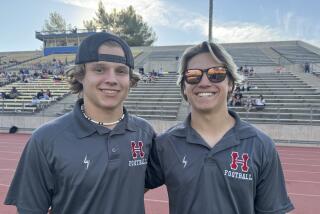Death Fuels High School Pole-Vaulting Concerns
NEWHALL — The death of a young Valencia pole-vaulter has added fuel to national concerns that within the relatively safe sport of track and field, vaulting may be too dangerous for high school athletics.
Heath Taylor, 17, came down near the edge of the landing mat and slid off, striking the back of his head on asphalt during a Tuesday afternoon practice at Hart High School in Newhall. He was taken to a nearby hospital and pronounced dead of severe head injuries at 7:55 p.m.
The school’s 20-by-22-foot landing mat exceeded national safety recommendations, but the hard surface around the landing area should have been covered with padding, according to published standards of the National Federation of State High School Assns.
California Interscholastic Federation (CIF) officials will investigate the death. Hart administrators said that as far as they knew, the pole-vault area was safe.
A pole-vault coach and a parent were supervising Tuesday’s vaulting practice as the Hart team prepared for a meet at Burroughs High in Burbank, school administrators said. Taylor was an experienced competitor who had set the bar at 10 feet, significantly below his personal best.
The junior cleared the mark easily, but something went awry with his landing. The back of his head struck the ground almost at the base of his neck.
Paramedics were called and Taylor, unconscious but still breathing, was airlifted to Henry Mayo Newhall Memorial Hospital, where he was later pronounced dead.
Mourning students placed flowers and balloons around the pole-vault area Wednesday. Practice went on as scheduled, though Taylor’s fellow vaulters did not participate. The team decided to compete in today’s meet as scheduled.
About 100 people--including students, faculty members and Taylor’s parents--attended a Wednesday evening vigil at the site of the accident. Wearing red ribbons in memory of his favorite red shirt, they read Bible verses and shared stories about his sense of humor and energy, and his enthusiasm for snowboarding and skateboarding.
Fellow athletes said he made up for his small physical size with his big heart.
He was the second best vaulter on the team, with a personal record of 11 feet, 6 inches, the students said.
“He’s in a better place,” said Trevon Wilson, 17, a teammate who called him an inspiration. “He won’t be forgotten.”
The team decided to dedicate today’s meet to Taylor.
Taylor lived in Valencia with his father. His mother and younger sister live in Camarillo. “Just before he went to track, he and the rest of the class were laughing at a joke somebody told,” said Muhaya Eddik, a senior in Taylor’s fifth-period class. “I don’t remember what it was, but I remembered he was laughing.”
Taylor was the second Southern California track athlete killed in a week. Last Tuesday, Palos Verdes Peninsula High School sophomore Craig Kelford III was accidentally struck in the head by a flying discus at a meet at North Torrance High.
His death has prompted new safety requirements put into place this week by the Torrance Unified School District, including limiting the number of discuses allowed during a competition and the addition of extra officials.
But track experts called the discus fatality a freak occurrence, saying pole-vaulting deaths are far more frequent.
“Besides football, where you can get catastrophic injuries, I’d say pole vault is the next most dangerous activity,” said Dean Crowley, a CIF commissioner and longtime track-and-field administrator. “You’re up there, suspended. It takes a lot of technique.”
Pole-vaulting is difficult because it requires sprinter’s speed combined with agility and upper-body strength. Vaulters sprint down a runway, plant their pole in a 6-inch-wide box and then propel themselves over a bar, landing on a thick, foam mat.
Between 1982 and 1994, vaulting accounted for nine of the 11 deaths in high school track and field nationwide, according to the National Center for Catastrophic Sports Injury Research in Chapel Hill, N.C. It also accounted for six permanent disabilities and five serious head and neck injuries.
By comparison, high school football programs had 52 deaths while baseball accounted for three during the same period.
“With the small number of pole-vaulters you have around the country, that is a large number of catastrophic injuries,” said Fred Mueller, the center’s director. “And they all happen the same way--the kid either misses the pit or bounces out of the pit and lands on a hard surface.”
The same type of accident happened March 7, when a 17-year-old Chicago Heights vaulter lost control while in the air and flew past the landing pit. He landed headfirst on the ground and was killed.
Faced with such injuries, state officials in Alaska and Iowa have discontinued pole-vault competition in recent years. So have a handful of Southern California leagues, including the eight-team Channel League in Ventura and Santa Barbara counties, as well as two Orange County leagues.
Cost is also playing a role. Over the past decade, the national federation has recommended additional safety equipment, mostly extra pads in and around the pit. Landing pads that meet national standards can cost as much as $6,000. Properly padded standards can cost $1,000.
In addition, the federation recommends that any “hard or unyielding surfaces” surrounding the pit be covered with “2-inch dense foam or other suitable material.”
“If someone is hurt and you’re not using the equipment mandated by the national federation, then you’re held to a higher level of liability,” said Gary Matthews, executive director of the Alaska School Activities Assn. “It got to the point where schools said we can’t afford it anymore.”
CIF investigators will be checking whether Hart conformed to prevailing equipment standards.
But track experts and administrators also worry about finding qualified coaches.
“You’ve got to have someone there watching where the kids put their hands, what kind of pole they are using,” said Crowley, who oversees 500 Southern Section schools in the area. “If you don’t have a competent coach, you’d better get out.”
Said Mueller: “Are there enough qualified coaches for all the high schools in the country? It’s hard to imagine that.”
For this reason, the Southern Section permits vaulters from competing schools to practice together if their league does not have enough qualified pole-vault coaches. In no other sport or event are such practices allowed.
And some vaulters have taken the extra precaution of wearing lightweight hockey or skating helmets. Toby Stevenson, a former Texas state champion who now competes for Stanford, began wearing one in high school.
“I wish I could get all my vaulters to wear them, but they won’t,” said Casey Roche, Stanford’s pole-vaulting coach. “They think the helmets look dorky.”
In their investigation of Taylor’s death, CIF officials will look into safety standards at Hart High, and will also consider if further precautions, such as helmets or spotters, are warranted.
“The purists in track and field want to keep the pole vault alive,” Crowley said. “And it should be kept alive. So if there’s some hole we need to fill in terms of safety, we will do that.”
Wharton is a Times staff writer and Sandoval is a correspondent. Times staff writer Eric Shepard and correspondent John Ortega contributed to this story.
(BEGIN TEXT OF INFOBOX / INFOGRAPHIC)
How the Tragedy Happened
Pole-vaulters use flexible fiberglass poles to propel themselves up and over a crossbar onto a landing mat. Hart High School vaulter Heath Taylor died during a vault Tuesday when he slid off the mat, striking his head on the asphalt.
THE FATAL VAULT
1) Taylor has a normal approach down runway.
2) Plants pole and rises toward crossbar.
3) Successful vault clears the crossbar set at 10 feet.
4) Lands toward back of landing mat and slides off end.
5) Strikes head on asphalt runway used for vaults coming from other direction.
Source: Encyclopedia Britannica; “Rules of the Game”, Hart High School officials
More to Read
Get our high school sports newsletter
Prep Rally is devoted to the SoCal high school sports experience, bringing you scores, stories and a behind-the-scenes look at what makes prep sports so popular.
You may occasionally receive promotional content from the Los Angeles Times.







